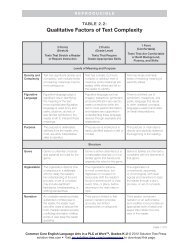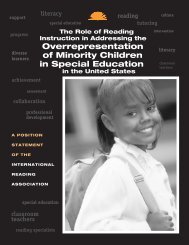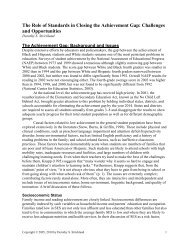Global Education Digest 2012 - International Reading Association
Global Education Digest 2012 - International Reading Association
Global Education Digest 2012 - International Reading Association
You also want an ePaper? Increase the reach of your titles
YUMPU automatically turns print PDFs into web optimized ePapers that Google loves.
CONTENTS<br />
Foreword 3<br />
Acknowledgements 4<br />
OPPORTUNITIES LOST / THE IMPACT OF GRADE REPETITION AND EARLY SCHOOL LEAVING<br />
Section 1 / Policy design and implementation of compulsory education systems 9<br />
1.1 Most out-of-school children have had some exposure to primary schooling 9<br />
1.2 When are children meant to enter school? How long are they supposed to stay in school? 11<br />
1.3 Do countries reach children of the intended age for compulsory education? 12<br />
1.4 Do education systems reach children of the intended ages? 14<br />
1.5 What are the major barriers or bottlenecks that hinder progression through the education system? 16<br />
Section 2 / Learning achievement: Differing policies and practices regarding grade repetition 17<br />
2.1 How is repetition defined, measured and evaluated? 17<br />
School life expectancy and repetition 19<br />
2.2 <strong>Global</strong> trends in pupils repeating grades in primary and lower secondary education 19<br />
Repetition trends in primary education show slight improvement depending on the region 19<br />
Repetition trends in lower secondary education show signs of improvement despite big enrolment<br />
increases 20<br />
2.3 Regional trends in pupils repeating grades in primary and lower secondary education 21<br />
Sub-Saharan Africa: Steady progress 21<br />
South and West Asia: Small signs of progress, especially in Nepal and Bhutan 24<br />
Latin America and the Caribbean: Repetition rates still high but some policy interventions<br />
show promise 24<br />
In other selected regions 25<br />
2.4 Which grades do children repeat the most? Country clusters show three patterns of repetition 27<br />
2.5 Which children are most likely to repeat? Usually children from poor families and rural locations<br />
are most at risk 28<br />
2.6 Inequity tends to decline as children make the transition to secondary education 30<br />
Section 3 / Early school leaving: Lost opportunities, lower potential 32<br />
3.1 Reached but then lost by the education system 32<br />
3.2 <strong>Global</strong> numbers and trends in early school leaving: Rates stagnating or dropping everywhere<br />
except sub-Saharan Africa 33<br />
3.3 Early school leaving by region 34<br />
Early leavers from primary education on the rise in sub-Saharan Africa, partly due to<br />
population increases 35<br />
Dropout rates stay high in South and West Asia despite demographic dividend 36<br />
5

















